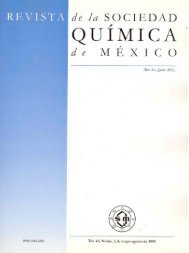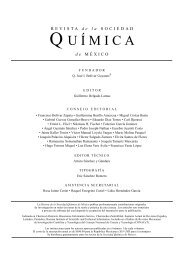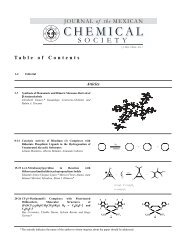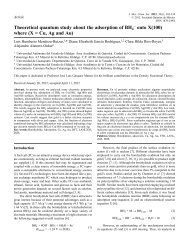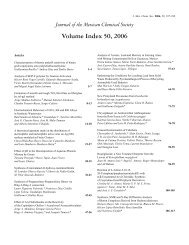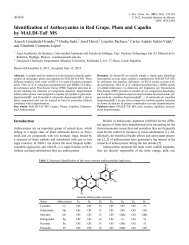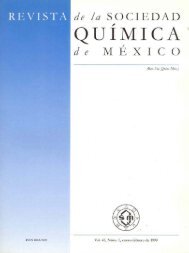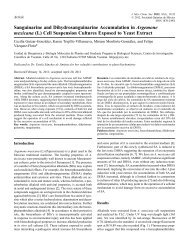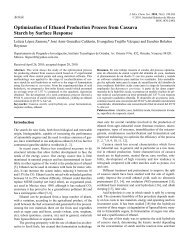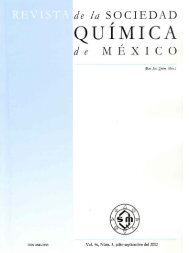SMQ-V047 N-002_ligas_size.pdf - Journal of the Mexican Chemical ...
SMQ-V047 N-002_ligas_size.pdf - Journal of the Mexican Chemical ...
SMQ-V047 N-002_ligas_size.pdf - Journal of the Mexican Chemical ...
Create successful ePaper yourself
Turn your PDF publications into a flip-book with our unique Google optimized e-Paper software.
144 Rev. Soc. Quím. Méx. Vol. 47, Núm. 2 (2003) Manuel Aregullin and Eloy Rodriguez<br />
Fig. 1. 1a (left) Adult tortoise beetle Physonota arizonae with typical Cassidinae morphology.<br />
1b (right) Larval stages <strong>of</strong> Physonota arizonae feeding on host plant Ambrosia ambrosioides and displaying defensive fecal shields (FS).<br />
Experimental<br />
Collection <strong>of</strong> Plant Material and Beetles. Ambrosia ambrosioides<br />
leaf material containing feeding Physonota arizonae<br />
beetles were collected from wild populations in washes, in <strong>the</strong><br />
Coyote Mountains <strong>of</strong>f <strong>of</strong> Hwy 86, approximately 20 mi. west<br />
<strong>of</strong> Tucson, Arizona during <strong>the</strong> months <strong>of</strong> July and August.<br />
The leaf plant material was brought to <strong>the</strong> laboratory, and <strong>the</strong><br />
beetles were removed manually and processed separately. The<br />
leaf plant material was air-dried and ground prior to solvent<br />
extraction, and from <strong>the</strong> beetles <strong>the</strong> exuviae and its resinous<br />
coating were collected and extracted fresh with organic solvents.<br />
Ambrosia ambrosioides Extraction and <strong>Chemical</strong> Analysis.<br />
Dried and ground leaf plant material (250 g) was extracted<br />
with 1500 mL <strong>of</strong> chlor<strong>of</strong>orm and magnetic stirring overnight.<br />
The chlor<strong>of</strong>ormic extract was filtered and <strong>the</strong> solvent evaporated<br />
to dryness in a rotavapor under vacuum. The residue was<br />
retaken in methanol to remove most <strong>of</strong> <strong>the</strong> hydrocarbons and<br />
filtered. The filtrate was evaporated to dryness to yield 24 g<br />
(9.6 %) <strong>of</strong> methanol soluble crude extract.<br />
The crude extract was dissolved in methanol and applied<br />
to a Sephadex LH-20 chromatographic column and eluted<br />
with methanol. Fractions from <strong>the</strong> column were collected<br />
according to <strong>the</strong>ir fluorescence under longwave light from a<br />
portable ultraviolet lamp. Fractions 1 and 2 showed to contain<br />
a mixture <strong>of</strong> hydrocarbons that was not fur<strong>the</strong>r characterized.<br />
Fraction 5 was shown to contain <strong>the</strong> sesquiterpene lactone<br />
Damsin (1). Fraction 6 was shown to contain <strong>the</strong> sesquiterpene<br />
lactone Damsinic acid (2). The structures <strong>of</strong> <strong>the</strong> two<br />
sesquiterpene lactones were established by spectroscopic<br />
methods (i.e., UV, IR, 1 H-NMR and 13 H-NMR, and MS), and<br />
comparison with au<strong>the</strong>ntic samples. Fractions 7-10 were<br />
shown to contain a mixture <strong>of</strong> flavonoids that was not fur<strong>the</strong>r<br />
characterized.<br />
Beetle Resinous Coating Extraction and <strong>Chemical</strong><br />
Analysis. Approximately 50 to 100 exuvia covered with feces<br />
were removed from <strong>the</strong> beetles and extracted fresh with chlor<strong>of</strong>orm.<br />
The chlor<strong>of</strong>ormic extract was filtered, and <strong>the</strong> solvent<br />
evaporated to dryness in a rotavapor under vacuum. The<br />
residue was redissolved in methanol, <strong>the</strong> insoluble fraction<br />
was discarded, and <strong>the</strong> filtrate evaporated to dryness to yield a<br />
gummy residue.<br />
The residue was dissolved in methanol and applied to a<br />
Sephadex LH-20 chromatographic column and eluted with<br />
methanol. Several fractions from <strong>the</strong> column were collected<br />
according to <strong>the</strong>ir different fluorescence under longwave ultraviolet<br />
light. Two fractions showed to contain each one a<br />
discrete sesquiterpene lactone that upon spectral analysis were<br />
shown to be Damsin (1) and Damsinic acid (2). The structures<br />
<strong>of</strong> (1) and (2) were established by spectroscopic analysis and<br />
comparison with au<strong>the</strong>ntic samples.<br />
Results and discussion<br />
Field observations have revealed <strong>the</strong> occurrence <strong>of</strong> <strong>the</strong> tortoise<br />
beetle Physonota arizonae on wild populations <strong>of</strong> canyon ragweed<br />
(Ambrosia ambrosioides), suggesting high host-plant<br />
specificity for this Asteraceae. All four life stages <strong>of</strong> <strong>the</strong> beetle<br />
(i.e., eggs, larvae, pupae and adults) were present on <strong>the</strong> host<br />
plant. Field observations also suggested that <strong>the</strong> appearance <strong>of</strong><br />
<strong>the</strong> beetle on <strong>the</strong> plant is closely associated with <strong>the</strong> initiation<br />
<strong>of</strong> <strong>the</strong> regional monsoon season that usually starts in July-<br />
August [9]. We suspected that <strong>the</strong> highly conspicuous accumulation<br />
<strong>of</strong> fecal matter (primarily derived from plant material),<br />
in combination with a discrete defensive behavior by <strong>the</strong><br />
nymphal stages, could be implicated in <strong>the</strong> chemical protection<br />
<strong>of</strong> <strong>the</strong> beetle from potential predators (i.e., birds, lizards, etc.).<br />
P. arizonae larvae, feeding on <strong>the</strong> plants, were collected<br />
from wild populations <strong>of</strong> A. ambrosioides to obtain enough<br />
material for chemical analysis. It was found that <strong>the</strong> fecal<br />
excretions covering <strong>the</strong> urogomphi were essentially lipophilic<br />
and that dissolved in chlor<strong>of</strong>orm ra<strong>the</strong>r easily. Thus, <strong>the</strong> chlor<strong>of</strong>ormic<br />
solution <strong>of</strong> <strong>the</strong> excretions was analyzed preliminary<br />
by tlc using a standard solvent system for terpenic chemicals<br />
(i.e., chlor<strong>of</strong>orm-acetone, 9:1) [10], <strong>the</strong> tlc plates were sprayed<br />
with a vanillin spray reagent highly specific for terpenoids<br />
[11]. This preliminary analysis revealed <strong>the</strong> presence <strong>of</strong> two<br />
major components in <strong>the</strong> excretion.




